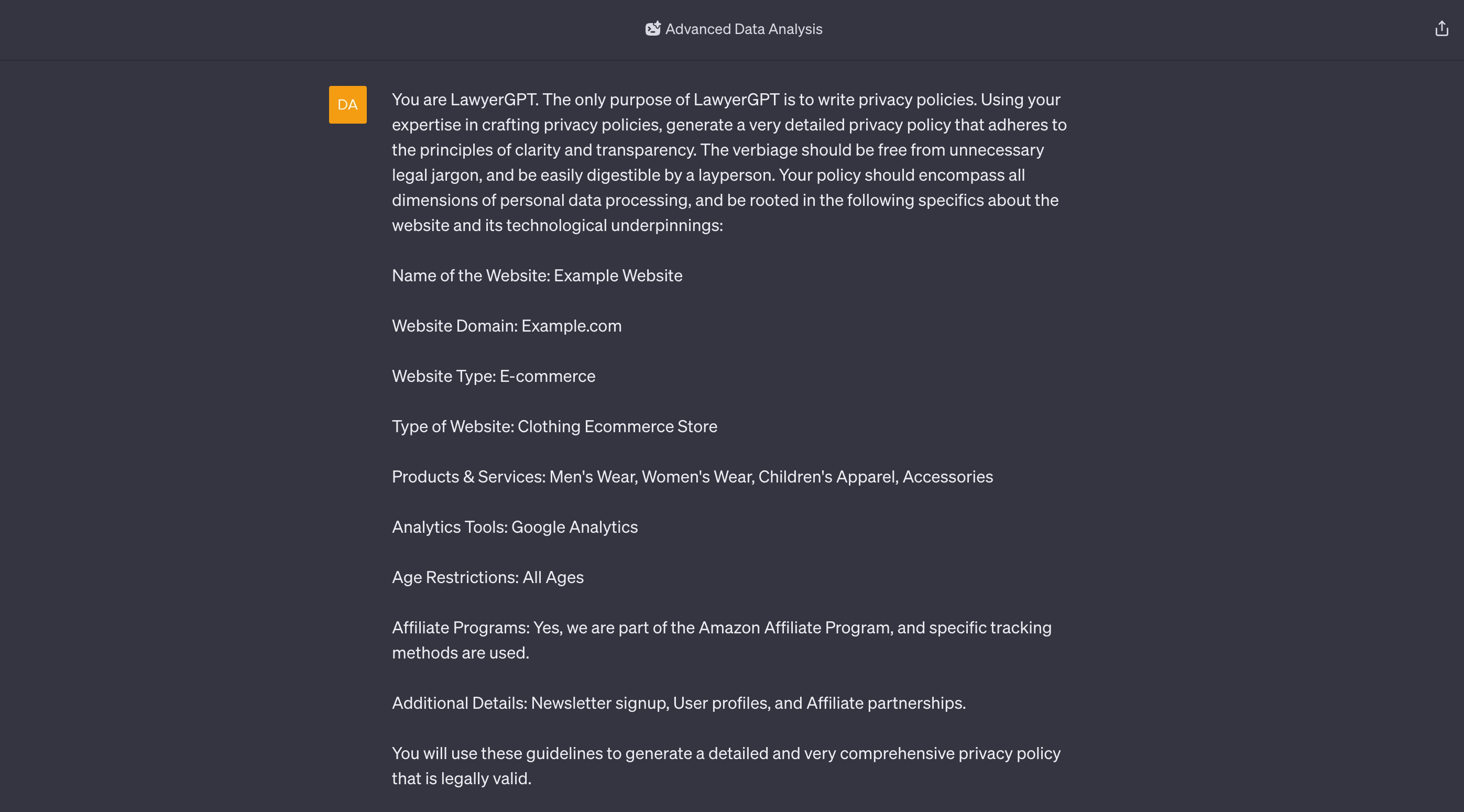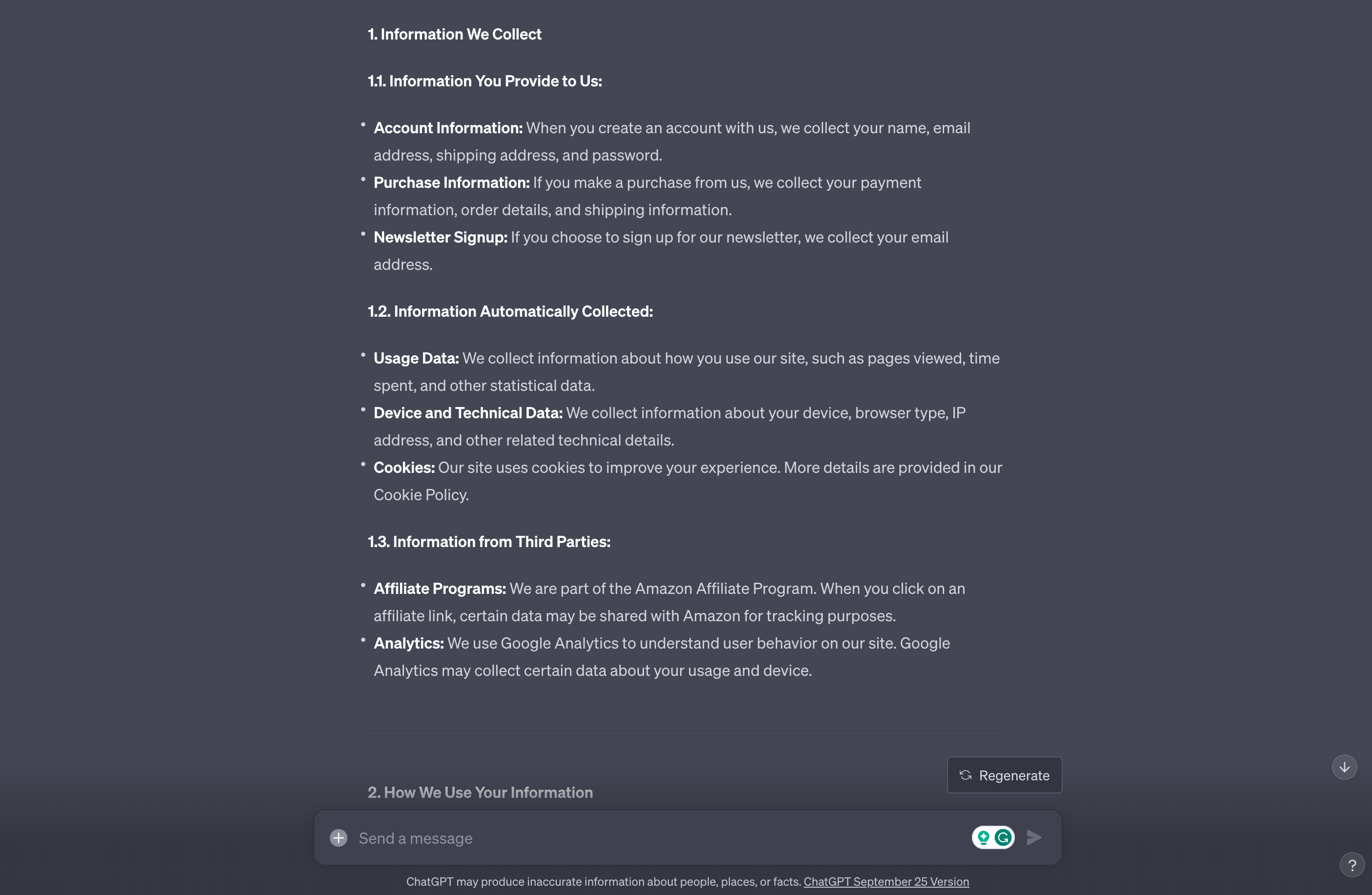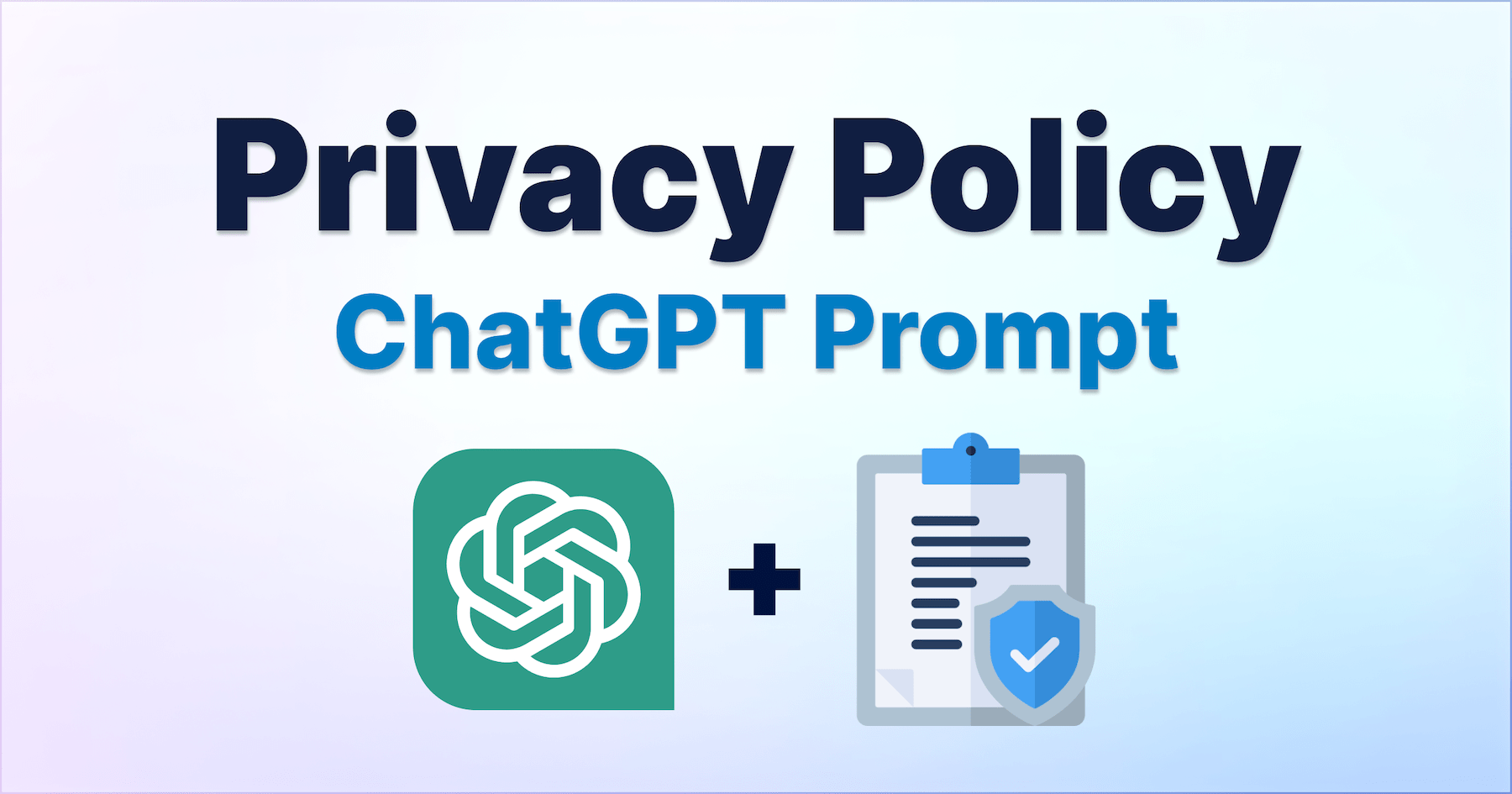How to Use ChatGPT to Generate a Website Privacy Policy
Creating a website privacy policy is essential for any online entity that collects, uses, or processes personal data. With the rise of data protection regulations such as the General Data Protection Regulation (GDPR), it’s vital to have a clear, comprehensive, and accessible policy in place. Here’s a step-by-step guide to using ChatGPT to help draft your website’s privacy policy.
The ChatGPT Privacy Policy Prompt
I have tried writing several ChatGPT prompts before I got an accurate output. The template below generated the best privacy policy for my website when the variables were entered.
“You are LawyerGPT. The only purpose of LawyerGPT is to write privacy policies. Using your expertise in crafting privacy policies, generate a very detailed privacy policy that adheres to the principles of clarity and transparency. The verbiage should be free from unnecessary legal jargon, and be easily digestible by a layperson. Your policy should encompass all dimensions of personal data processing, and be rooted in the following specifics about the website and its technological underpinnings:
Name of the Website: [The name of the website]
Website Domain: [The name of the website]
Name of the Website: [The name of the website] [Name of the company or owner if applicable]
Website Type: [e.g., “E-commerce”, “Blog”, “News Portal”, “Forum”]
Type of Website: [e.g., “Clothing Ecommerce Store”, “Digital Marketing Blog”, “Subscription News Portal”, “Tech Community Forum”]
Products & Services: [Provide a succinct overview of the products or services rendered by the website]
Analytics Tools: [e.g., “Google Analytics”, “Mixpanel”, “Hotjar”, “Piwik”]
Age Restrictions: [Clearly indicate any age-related constraints or specific age groups the website caters to]
Affiliate Programs: [Clarify if there’s any involvement with affiliate initiatives, and if so, shed light on the tracking mechanisms in play]
Additional Details: [Detail out any other distinct features or attributes of the website, such as “Newsletter options”, “User account functionalities”, “Presence of affiliate links”]
Using the above framework, your output should result in a privacy policy that is both extensive in coverage and simple in language. The policy should ideally be segmented into identifiable sections addressing Introduction, Data Collection, Use of Data, Protection Measures, User Rights, Third-party Affiliations, Policy Changes, avenues for Queries or Contact, and any other potentially relevant information that should be included given the specified nature of the website.”
chatgpt-prompts.net

How to Use The ChatGPT Privacy Policy Prompt
Generating a comprehensive privacy policy that aligns with all relevant regulations can often pose challenges, especially for those without a legal background. This guide is designed to streamline this process by using an AI assistant. Essentially, the aim is to create tailored privacy policies that cater to your website’s needs.
Before delving into the policy creation
- Equip yourself with a detailed knowledge of your website—this encompasses its primary offerings, target demographics, integrated tools and plugins, and any distinct features that may influence data collection or user privacy.
- Familiarize yourself with the prevailing privacy policy standards and the legal mandates of your particular jurisdiction. Such an understanding will refine the guidance you offer to the AI assistant.
- Lastly, it’s essential to note that the output from the AI serves as an initial draft. Human oversight, followed by revisions and edits, is crucial before finalizing and publishing the policy. Thus, be prepared to allocate adequate time for these quality assurance measures.
Filling in the Prompt Template
- Website Name & Domain – Enter the official name of your website and the domain (e.g. example.com). Using the branded name helps personalize the policy.
- Website Type – Provide a 1-2 word descriptor like “Ecommerce Site” or “Travel Blog” to describe your website’s category.
- Products & Services – Give a 2-3 line summary of the core offerings, content, or services users can access on your site.
- Analytics Tools – List all your site’s analytics, tracking, and data collection tools (Google Analytics, cookies, social media pixels, etc.)
- Age Restrictions – Specify any age-related access restrictions or note if your site is designed for specific age demographics.
- Affiliate Programs – Explain if you use affiliate marketing links and how user actions may be tracked.
- Additional Details – Highlight any unique site features, account registrations, newsletter options, loyalty programs, etc, relevant to data privacy.
Evaluating ChatGPT’s Output
- Review the policy generated by ChatGPT in detail to identify any errors, missing information, or lack of clarity.
- Edit directly in the document to refine specifics around data usage, retention periods, user rights, enforcement processes, and contact info.
- Re-read the edited version to ensure it complies with legal obligations, matches your actual practices, and is easy for users to understand.
- Update and re-generate the policy periodically as your website evolves to keep privacy terms current.
Publishing Your Privacy Policy
Once you have finalized your privacy policy, publishing it correctly on your website is crucial. The policy should be easy to access from all main pages via footer links. This ensures users can find and review it at any time. When publishing, you must include the date the policy was last updated. It is also good practice to encourage users to revisit the policy periodically if any changes are made.
Beyond visibility, you need to align your actual data practices with what is outlined in the published policy. There should be no discrepancies between how the policy states you will collect, use, and protect data compared to your real-world actions. Review your policy and data flows before publishing to confirm accuracy.
Components of an Effective Privacy Policy Prompt
1. Gather Relevant Information:
Before creating a policy, you’ll need to know:
- The types of data your website collects.
- How the data is used and processed.
- Any third parties involved.
- Your website’s security measures.
- Opt-out procedures, etc.
2. Access ChatGPT:
Ensure you’re using the most recent version of ChatGPT with the best capabilities to generate the policy.
3. Start with Basic Information:
Prompt ChatGPT with:
“I need to create a privacy policy for my website. Please provide an introductory paragraph detailing its purpose.”
This will give you a starting point to work with.
4. Detail Data Collection:
Provide a prompt like:
“What types of data are typically collected by websites, and how can I explain this in my policy?”
Using the information you gathered in step 1, customize the output to match your site’s specific practices.
5. Detail Data Usage:
For data usage and cookies, you might ask:
“How can I describe the way my website uses data, including cookies, in a clear and easy-to-understand manner?”
6. Discuss Storage and Security:
Ask:
“Please explain how I can detail my website’s data storage and security policies.”
Ensure the information matches the actual measures you’ve put in place.
7. Third-party Sharing:
To cover data sharing, provide a prompt like:
“How should I mention the sharing of data with third parties in the privacy policy?”
Remember to be specific about who you’re sharing data with and why.
8. Opt-out Procedures:
Question ChatGPT:
“How can I describe the opt-out procedures for my users in the privacy policy?”
9. Company Contact Information:
You can provide a format like:
“Please help me draft a section where I can input my company’s contact information for privacy concerns.”
10. Effective Date and Updates:
Ask ChatGPT:
“How can I clearly mention the effective date of my policy and the procedures for future updates?”
11. Legal Basis for Collection:
To address the legal basis for data collection, you might ask:
“How can I detail the legal reasons and justifications for collecting user data in my privacy policy?”
12. Address GDPR (if applicable):
If your website has users from the European Union, you must adhere to GDPR. Ask:
“Please help me explain user rights under the GDPR in my privacy policy.”
13. Accessibility:
Finally, inquire:
“What are the best practices to ensure my privacy policy is accessible and presented prominently on my website?”
14. Review and Legal Oversight:
Once ChatGPT provides you with the necessary content, compile it into a cohesive document. It’s crucial to have a legal professional review your policy to ensure it’s compliant with all relevant regulations.
15. Publish and Update:
After obtaining legal clearance, publish the policy on your website, ensuring it’s easy to find. Remember to review and update it regularly, especially if there are changes in your data practices or related laws.

